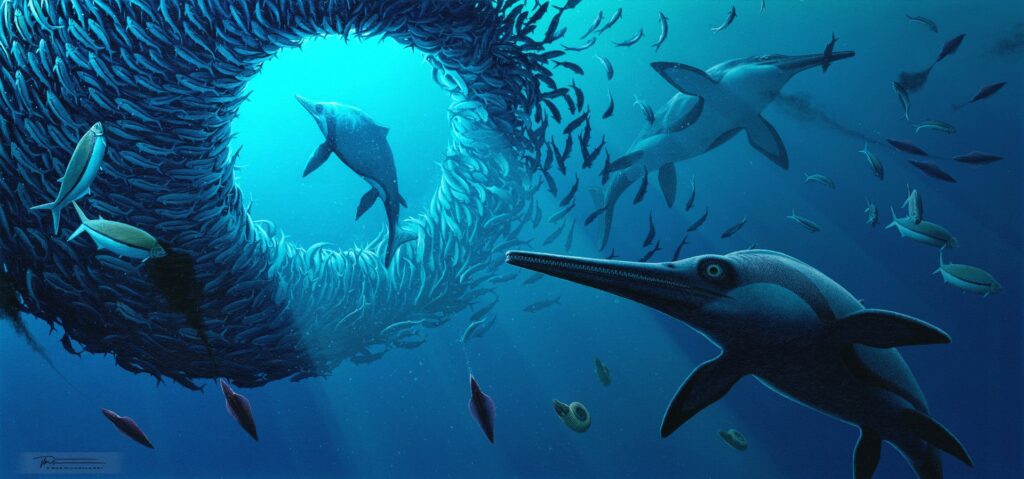
A fossil unearthed over two decades ago on England’s Jurassic Coast has emerged as one of the most significant marine reptile discoveries in recent history. The nearly complete skeleton of a long-snouted ichthyosaur, now identified as Xiphodracon goldencapensis, or the “Sword Dragon of Dorset,” is providing scientists with crucial insights into an incomplete chapter of evolution during the Early Jurassic era, approximately 193 to 184 million years ago.
Uncovering a Sea Dragon
The fossil was initially discovered in 2001 at Golden Cap, a cliff along the southwest coast of England, by local collector Chris Moore. It was subsequently relocated to the Royal Ontario Museum in Canada, where it remained largely intact until scientists from the University of Manchester and other institutions revisited it. Dr. Dean Lomax of the University of Manchester, upon examining the fossil in 2016, immediately recognized its uniqueness. “I knew it was abnormal at the time but did not anticipate that it would turn out so significant to filling a gap in what we know,” Lomax explained. The team’s study confirmed it as a new species.
Measuring approximately three meters in length, Xiphodracon was similar in size to a modern dolphin. It featured a large eye socket and a wide, sword-like snout lined with sharp teeth—ideal for catching fish and squid in ancient oceans. Its name derives from the Greek xiphos (sword) and dracon (dragon), reflecting the “sea dragon” moniker that ichthyosaurs have held for over 200 years.
A Window on a Lost World
The Early Jurassic Pliensbachian stage has long been a frustrating gap in the fossil record. While thousands of ichthyosaur skeletons have been found from before and after this period, fossils from within the Pliensbachian are rare. This missing information has left scientists curious about the evolution of sea reptiles during this epoch.
Prior to the discovery of Xiphodracon, researchers noted significant differences between ichthyosaur genera before and after the Pliensbachian, despite their occupying similar ecological niches. The new fossil indicates that this evolutionary “turnover” occurred earlier than previously thought. Its presence suggests stronger affinities with taxa of the later Toarcian age, extending the timeline of when newer ichthyosaur clades began replacing older ones.
“This is a key time for the ichthyosaurs because a few of the families did become extinct and some new ones cropped up,” Lomax said. “But Xiphodracon is one that you can say is missing from the ichthyosaur jigsaw.”
Anatomy, Injuries, and Signs of a Struggle
The fossil is remarkably well-preserved, with nearly the entire skeleton intact and three-dimensional, unlike the typically flat fossils. The only missing parts are a single hind flipper and the tail tip. Researchers also discovered signs of trauma: tooth marks on the skull suggest the reptile was bitten by a larger predator, possibly another ichthyosaur. Some teeth and bones show signs of disease or stress, offering insights into the dangers of Jurassic oceans.
One particularly intriguing feature caught scientists’ attention: a prong-like bony bump near the nostril, part of a bone called the lacrimal. No other ichthyosaur is known to possess such a feature. Its purpose remains a mystery—it may have influenced breathing, streamlined swimming, or enhanced sensory perception—but it suggests these animals were more anatomically diverse than previously thought.
Filling Evolution’s Gaps
Paleontologists refer to periods like these as “faunal turnover,” where old species die out and new ones emerge. Ichthyosaurs experienced such a shift during the Pliensbachian, but researchers could not previously pinpoint when the turnover began. Xiphodracon completes the missing record, indicating that the evolutionary change was gradual rather than abrupt.
As co-author Professor Judy Massare of the State University of New York stated, “Thousands of complete or nearly complete ichthyosaur skeletons are known before and after the Pliensbachian. Something catastrophic happened to species diversity sometime during the Pliensbachian, that’s certain. Xiphodracon allows us to pinpoint when the change took place, but we still don’t know why.”
The “why” remains one of paleontology’s greatest questions. Potential causes include climatic change, sea temperature fluctuations, or competition for food. Each new fossil discovery from this time could reveal more pieces of the puzzle.
The Long Journey to Discovery
Xiphodracon sat unrecognized in the Royal Ontario Museum collections for decades. Its significance only became apparent with new analytical techniques and comparisons. This story underscores the value of museum archives, where even fossils stored for centuries can hold solutions to scientific puzzles.
The fossil will eventually be displayed at the Royal Ontario Museum in Toronto, allowing the public to view what paleontologists are calling the most complete Pliensbachian marine reptile skeleton on Earth. This discovery reaffirms that the Jurassic Coast—already a global fossil hotspot—still holds many secrets.
Questions Still Unanswered
Despite the insights provided by Xiphodracon, much remains unknown. Why did it possess its unique prong-like snout bone? How common was the species—was it confined to the seas around England, or did it have a broader range? And why did the general ichthyosaur turnover occur during the Pliensbachian?
Scientists hope that continued fieldwork and studies of existing museum specimens will provide answers. Each new find can refine the timeline of how these swift, dolphin-like reptiles developed and thrived in prehistoric oceans.
Practical Implications of the Research
This discovery not only reshapes the ichthyosaur family tree but also alters our understanding of how evolution unfolds in marine environments. By placing Xiphodracon goldencapensis as an early representative of subsequent ichthyosaur groups, researchers can more accurately reconstruct evolutionary leaps.
The research also highlights the importance of maintaining museum collections and examining specimens, where overlooked fossils can still challenge our understanding. More broadly, it demonstrates that radical evolutionary transformations can occur slowly and unnoticed, rather than suddenly—a lesson applicable to studying diversity and extinction in today’s rapidly changing marine ecosystems.
Research findings are available online in the journal Papers in Palaeontology.




